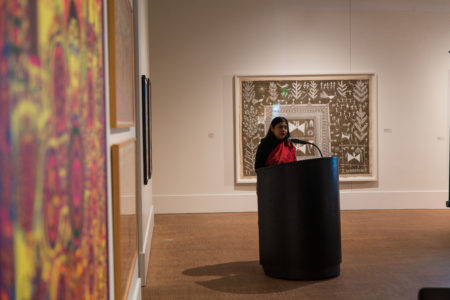By Saiham Sharif
sharifsa@grinnell.edu
Last Tuesday Nov. 7, Rashmi Varma, an associate professor of English at the University of Warwick in England, delivered a Faulconer Gallery talk on how the art of indigenous communities can land in private collections. This topic provided a lens into postcolonialism, aesthetic challenges and culture. Her presentation is a part of the current Faulconer Gallery exhibit on Indigenous Indian Art.
She began her speech with a striking example that captures the life of many indigenous artists.
“In 2001, a small newspaper column in India had reported that Jangarh Singh Shyam had committed suicide in Tokamachi, Japan,” Varma said. “There are two or three of his works here. Jangarh was a tribal, Adivasi artist, who belonged to the Pardhan clan of Gond tribe from central India. Working in contracts and privately owned millionaire museums in Japan, where he had been brought to produce a body of work for a running salary of about $200. Much is not publicly known about the circumstances leading to his death, whether his suicide was a culmination of an act of depression, or luminous in a foreign plan, or an act of desperation and cognitive dissonance, against the exploitative conditions of the globalized production of art. His death was both a catastrophe and an omen.”
Impoverished, many indigenous artists must hold day jobs, stealing away rare free moments to work on their art. Mostly through the lens of Jangarh, Varma focused on the Adivasi community, who comprise eight percent of India’s population and constitute a marginalized community. She touched on the storytelling role of artists in communities, and how capitalism disrupts culture through its relentless commodification.
Some modern Goan art includes depictions of gods and goddesses, but Verma believes, “there is absolutely no evidence in [indigenous] Goan culture of visually representing their gods and goddesses.”
However, the art market, reflecting the desires of private individuals who expect certain cultural icons in art, compels distortions. Consequently, indigenous artists create works that appeal to consumers, and thereby change the perception of their culture.
“My contention in this talk is that any critical interpretation of Adivasi art must draw upon the material economic and symbolic observation of its emergence and presence in postcolonial India and beyond,” Varma said.
Delving into the mechanics of Marxist theory, she explained how specifically primitive accumulation, also known as the private accumulation of capital, contributes to the suffering of many indigenous artists.
Primitive accumulation entails the enclosure of private property, a recurring theme in India’s colonization and current globalization. When private property is reserved for the wealthy, the poor are then displaced and must move elsewhere to live. Art is an extension of this accumulation. Once publicly supported, art is now privately held mainly in special collections. Capitalism thereby demands culturally impure art and the subjugation of the poor.
Varma connected a Ramachandra Guha’s quote to the state of Goan art.
“‘In the history of Independent India, the most bloody conflicts have taken place in the most beautiful locations,’” Varma quoted. “There is a similar structure of feeling in Goan art, radiating from the beautiful pictures of trees, inhabited by magical creatures, people dancing. In [this] art there is a feeling of loss that emerges from only the destruction and enclosure of forests and many peoples, but also culture, a pervasive theme.”

Photo by Govind Brahmanhyapura

























































